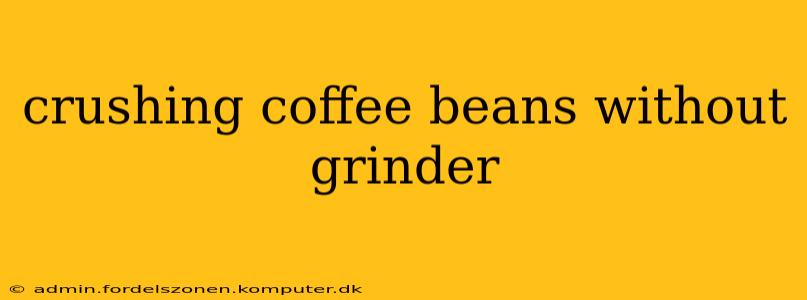So, you're craving that rich, aromatic coffee but find yourself without a grinder? Don't despair! While a burr grinder is ideal for consistent particle size, there are several effective methods for crushing coffee beans without one. This guide explores these alternatives, offering insights into their pros, cons, and best uses.
What are the best ways to crush coffee beans without a grinder?
This question lies at the heart of many a caffeine-deprived morning. The truth is, the "best" method depends heavily on your available tools and desired outcome. Let's break down several viable options:
1. Using a Mortar and Pestle:
This traditional method offers a surprisingly effective way to crush coffee beans. The mortar provides a stable base, while the pestle allows for controlled crushing. The result is a somewhat coarse grind, perfect for French presses or percolators.
- Pros: Relatively even grind, good control over coarseness.
- Cons: Time-consuming for larger quantities, can be messy.
2. Employing a Rolling Pin:
Similar in concept to the mortar and pestle, using a rolling pin on a sturdy surface provides a simple yet effective method. Place the beans in a sturdy, sealable bag (like a freezer bag) and roll the pin over them, applying gentle but firm pressure. Repeat until you reach the desired coarseness.
- Pros: Simple, readily available tools.
- Cons: Inconsistent grind size, potentially messy if the bag breaks.
3. Leveraging a Heavy-Duty Ziploc Bag and a Hammer (or other heavy object):
This isn't a precise method, but it works in a pinch. Place the beans in a heavy-duty Ziploc bag, seal it tightly, and gently tap it with a hammer or mallet. The resulting grind will be extremely coarse, better suited for very strong brews.
- Pros: Quick and effective for a very coarse grind.
- Cons: Very uneven grind size, risk of breaking the bag, not suitable for delicate brewing methods.
4. Utilizing a Spice or Herb Grinder:
If you have a small spice or herb grinder (often electric), these can be repurposed to crush coffee beans. Use short bursts to avoid overheating and potentially burning the beans.
- Pros: Relatively fast for smaller quantities, more consistent than a hammer.
- Cons: May require cleaning afterward, limited capacity.
How does the grinding method affect the taste of coffee?
The size of your coffee grounds significantly impacts the extraction process and, consequently, the taste. A finer grind extracts more quickly and intensely, leading to a stronger, potentially bitter brew. A coarser grind, on the other hand, results in a milder, less bitter cup. Using less-than-ideal crushing methods often results in an uneven grind size, leading to inconsistent extraction and a less balanced taste.
What are the different brewing methods for crushed coffee beans?
Given the typically coarser grind achieved with these methods, French presses, percolators, and even coarse-grind drip coffee makers are your best bets. Avoid using very fine methods like espresso machines, as the uneven grounds can clog them.
Can I use pre-ground coffee instead of crushing my own beans?
Absolutely! Pre-ground coffee is readily available and convenient. However, keep in mind that it loses its aroma and flavor more rapidly than whole beans. If freshness is a priority, grinding your beans immediately before brewing is always recommended.
This article provides a comprehensive guide to crushing coffee beans without a grinder, offering detailed explanations of various methods, their effects on taste, and suitable brewing methods. Remember to choose a method based on your needs and available tools. Enjoy your coffee!
